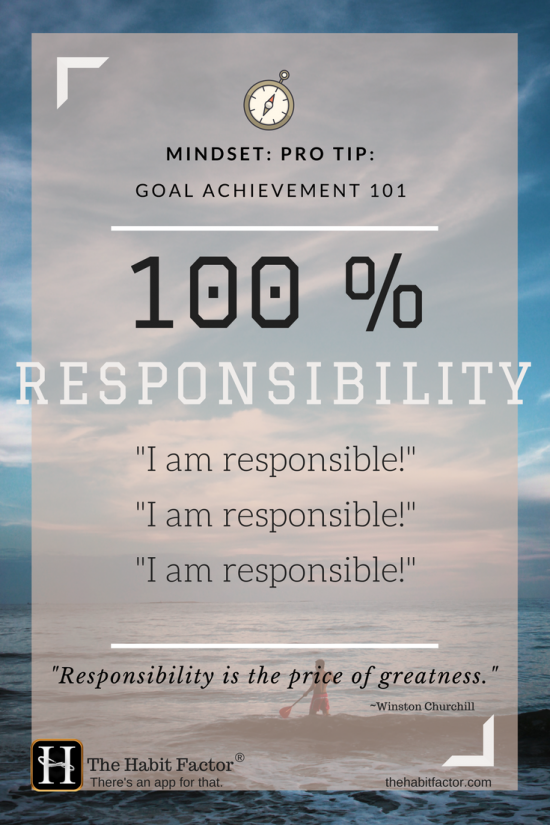
“Responsibility is the price of greatness.” ~Winston Churchill.
By: Martin Grunburg
Continuing our Goal Achievement Series “G.R.O.W.I.N.G.,” today’s topic brings us to perhaps the most important and pronounced trait of those whom we consider “great” and “successful” — RESPONSIBILITY.
This key attribute and mindset is universal in all great goal achievers. Responsibility simply cannot be extracted from any “success equation.” Just try to imagine any historical great or person you deem “successful” who doesn’t take responsibility — that is, who blames their results or their situation on others and makes excuses.
Responsibility is the starting point and, in many ways, it is the ENDING point.
As Harry S. Truman was fond of saying, “The buck stops here!”
When you start with 100 % responsibility you are saying to the world, “I am capable of creating my ideal future.” When you take 100% responsibility, things begin to change.
Don’t believe this? Consider the exact opposite mindset: “I’m not responsible for my choices, actions or the outcomes in my life.”
What sort of results is that mindset likely to produce?”
Got Excuses?
Nothing in this world may be recycled more than excuses. (Feel free to tweet that quote ; ) If we’re busy creating excuses, we’re not creating results!
Here’s your 100% Responsibility Checklist:
I <NAME> Fully Commit To Taking 100% Responsibility for:
MY CHOICES! (each item represents a choice)
my attitude
my decisions
my habits
my goals
my level of well-being (weight, fitness, peace of mind)
my happiness (nobody can make you unhappy without your permission)
my relationships
my level of growth!
my charitable giving
my belief and faith in myself
my self-worth and self-esteem!
Watch Jim Rohn explain the value of 100% responsibility!
My favorite part may be his “reasons for not looking good” and his “blame list,” and when Shoaff says, “There’s just one problem with your list…”
Haha! Looking for a little more on the topic! Check out these By: Martin Grunburg Change is a funny thing. In fact, one of the great constants (by definition, something that never changes) is, in fact, change. The great thing about goals is they allow us, in this crazy and uncertain world, to direct some of the change. By doing this, goals provide a sense of purpose, direction and, yep, you guessed it, “control.” What I didn’t fully understand before is that a sense of control is linked to our general happiness. That’s right: The more we feel we have some sense of “control,” the better — and happier — we are likely to feel. Simply by setting goals and taking action toward them, you will feel more in control, and that will make you feel better/happier about your life. A Different Perspective on Goals? Now, you may be somewhat confused if you’ve noticed some recent blog posts and even studies that suggest goal-setting can backfire, becoming self-defeating, disappointing, discouraging and even depressing. It’s important to put these ideas into perspective and understand them a little better. The more I review and research them (a few links below), the more I notice some commonalities. These studies tend to cite a goal-achievement process where the emphasis is on the goal itself, with little or no mention of the process that helps to ensure goal achievement — one that focuses on the core, recurring behaviors (habits) rather than the goal. Recall, The Habit Factor (as a goal-achievement method) proposed the idea of focusing on core, supportive habits rather than something like S.M.A.R.T. goals, and then developing these habits following the P.A.R.R. methodology. If you check out this article specifically in Psychology Today, titled: “Why Goal Setting Doesn’t Work” (imagine that ; ), you’ll notice in the seventh paragraph the author writes, “inherent problem with goal setting is how the brain works…” She then goes on to say, “Therefore, any goals that require substantial behavioral change or thinking-pattern change will automatically be resisted.” Yep! The key phrase there is “behavior change.” Of course, this is precisely why The Habit Factor® Method has been so popular and effective; it focuses first and specifically on the behavior change itself (habit development) as a process to achieve the goal. It’s important to set goals and then concentrate our efforts and focus on the behavior change itself — the new habits that will carry us to our BIG goal. In fact, this is precisely why YOU can take The Habit Factor Method to the bank! Other methodologies such as SMART goals entirely miss the concept of habit development to achieve goals. The other issue brought up when it comes to goal achievement is the “right mindset.” Do you have a “fixed” or a “growth” mindset as you pursue your goal? There is more on exactly what all that means in great detail here, PDF, but one of the key ideas/mindsets for a goal achiever is the idea that they are always growing! Therefore — think about this — technically they never arrive. Now, I recognize that may sound awfully discouraging, but with the Growth Mindset (taking action and getting better every day), the flip side is you are always arriving, every day. ; ) Finally, it’s worth noting that the majority of these papers and studies, such as Harvard’s “Goals Gone Wild,” analyze organizational goals vs. individual, personal goals. And, of course, with organizational goals there are a host of other variables (including the goal itself) that are out of our control (remember control’s link to happiness). To sum this all up: 1) Always Be Growing Key questions to ask yourself: Do you have a big goal set in three, six or even 12 months? Have you taken action toward your BIG goal today? Are you focused on the process — the habits — or the outcome? What is the process you are using? Does it involve development of the essential habits required to achieve the goal? Do you have the right tools to ensure those habits are being developed? The tools to achieve change, growth, control — and ultimately happiness — are here and ready to help you on your way. For a refresher or even an introduction, here is The Habit Factor Method (Free, Habit Tracking Sheet) and How to Use P.A.R.R. (video) or, you can watch it below. Until next week, ~mg Don’t forget the app is free (iOS and Android). A few articles/studies to reference: Goals Gone Wild: http://www.hbs.edu/faculty/Publication%20Files/09-083.pdf Grit: Perseverance and Passion for Long-Term Goals Psychology Today: Why Goal Setting Doesn’t Work (my favorite ; ) By: Martin Grunburg Just over a year ago my youngest daughter Eva, decided to run for student council president (as an eight grader). Upon hearing her decision my first tendency was to shield/protect her from the pain of a potential loss. However, I managed to contain myself and any impulse to intervene (I said nothing). I’m glad that I did— she won. What I found even more fascinating (than her victory) was that when she set out to write her speech she titled it, (get this) “The Best Speech Ever!”. I just laughed… that’s funny I thought. Eva’s always had a great sense of humor and a very mature, dry, quick wit (compliments of her mother) but I suspect there was a little more to the speech title than meets the eye. “The Best Speech Ever!”? Seriously? Who says that? Who writes such things? I mean that sounds a little or a lot audacious and perhaps even arrogant? Eva is none of those things. She’s rather humble, quiet and thoughtful young lady. I mean I’ve written a handful of speeches in my life and have never even once, considered titling any of them, “The best speech ever!” “The Best Speech Ever!” Absurd right? Move over Abraham Lincoln, MLK and Franklin Deleanor Roosevelt At this point, you may be wondering, “Well was it any good? Was it the best speech ever?” Not exactly. It a good speech that helped her win for sure but nobody is sending it to the Library of Congress. However, the more I pondered it (the title specifically) the more interesting it became. What could I learn from our little eighth grader’s bid to win her Student Council Presidency? And, here is the answer, drum roll please… Why bother, if you don’t fully believe? That’s right… Why bother going after that goal if you don’t believe it’s possible? I’m sure that sounds overtly simple, trite and cliche. But really think about this seriously, “What is the point of expending any effort or energy if you don’t fully believe you can do it— that you’ll achieve your goal? Why are you even going to attempt it if “you’re not in it to win it” as the saying goes? What is the point!? I know this seems like a real no-brainer, totally obvious yet that is precisely why it demands our attention. I’ve made a second career out of analyzing the obvious at this point so why let this one escape. I can’t tell you how many times I’ve just gone through the motions myself… putting in time, energy and attention toward some goal with the thought, “Look, we’ll give it a go and if it doesn’t work out, that’s alright— you never know, we’ll see what happens.” (think old Jewish rabbi voice with palms facing upwards shrugging shoulders. ; ) So, what’s wrong with proceeding with that mindset? Well, that’s the voice of pragmatism — not belief. Pragmatists are great when it comes to looking backward, commenting, criticizing and critiquing. Identifying what, where and when things went wrong and how they could have gone better or different. And, our society loves to criticize and judge everything! Think about it, today’s most popular TV shows involve “judges” or critics. Here’s the problem though when it comes to goal setting: GOAL SETTING IS ABOUT THE FUTURE! People who create the future aren’t and have never been known as pragmatists. Nobody has ever called Henry Ford, Thomas Edison, Albert Einstein, Steve Jobs or Elon Musk pragmatists. Instead they were all labeled visionaries. Vision is rooted in belief. Belief is essential to creativity. Goal achievement is creation! This is a why one of the smartest (most knowledgeable) men in history, Einstein, proclaimed, “Imagination (vision) is more important than knowledge.” The future comes one day at a time and the best way to predict the future is create it. While it’s essential to know which way the wind is blowing ; ) (more great cliches) here’s a singular truth: No great achiever, visionary or creator was known to be a pragmatist. He/She was a visionary first— a creator who believed in her ability and vision long before anyone else. A few questions for you: What’s your biggest goal at the moment? On a scale of 1-10 what is your belief that you will achieve it? Who determines if you are right or wrong? Who knows for certain what the outcome will be? Ask yourself, what’s the value of beginning toward your goal if you don’t believe it’s possible? Always remember, “There has never been a statue erected to honor a critic”. Believe. Until next week, ~mg By: Martin Grunburg The last two weeks we’ve focused on the simple idea that rather than trying to distinguish and separate habit and skill (something even top behavioral psychologists struggle to differentiate), it may serve us to take a moment and wrap our minds around their powerful similarities. Let’s strengthen the link between these two important concepts. In psychology there is something known as the “four stages of competence,” originally described (get this) as “The Four Stages for Learning Any New Skill” (emphasis on the skill). The four stages of “learning any new skill” or “competence” relates specifically to the psychological states we experience as we progress from incompetence to competence amid the acquisition of a new skill. What’s fascinating to me is that the highest level of competence is identified as “unconscious competence,” emphasis on the unconscious. Couldn’t that just be labeled the “habit level of competence“? For example, let’s think about a concert pianist or really any virtuoso — maybe even a jazz musician. When such an artist is performing at their highest level, there is little if any conscious thought involved. For instance, the pianist isn’t thinking, “Now, do I put my index finger on the C?” They are completely captivated and “in the moment.” You could also say they are “in the zone.” (For more on the essence of the zone, check out this post https://thehabitfactor.com/2016/01/the-key-to-peak-performance-and-the-zone-is-habituation/ or find even more here in The Pressure Paradox where I explore the topic extensively.) Let us revisit exactly what the four basic levels of learning or competence are comprised of: Phase I: Unconscious Incompetence: At this level, the person doesn’t even know what he/she is doing or how bad at any particular skill or task they are. A good example of this might be the skill of managing others: Many managers, especially new ones, begin at this first level — and this can be a dangerous place for your career should you not evolve and move to the next level. For instance, a new manager might not even know that he or she is a bad manager; this ignorance might prevent him from moving to the next phase of learning and may even result in being fired. Phase II: Conscious Incompetence: They know they are not good at managing people, so they begin to learn. They start adjusting their management “style”and develop some basic management skills. They are still not too good at the skill/task (in this case managing people), but they at least recognize that fact and they are taking steps to learn and become better. Phase III: Conscious Competence: At this level the manager is much better at managing people (they are competent), but the skill/task remains challenging. It’s hard work, and they continue to practice and learn how to become a better manager. They put in the effort day after day until they reach . . . Phase IV: Unconscious competence: Now, after years of management experience and routinely practicing, modeling and learning the behaviors of a skilled manager, the skill of managing people has finally become “second nature.” This, of course, explains the desire of most companies to hire people with experience. At this level of competence — the highest level — the manager’s decisions and actions are “habit-like,” requiring very little conscious effort and exuding a high level of competence. Moving to “Mastery” When it comes to mastery and “success,” it’s a bit of a cliche these days to cite Malcolm Gladwell’s “10,000 hour rule,” yet it’s unavoidable here ; ). In his great book Outliers, Gladwell sets out to dispel many of the common myths behind what it takes to become a “success.” Throughout the book he cites numerous “outlier” instances responsible for helping to create one great success story after another. However, there is one constant among all the great success stories. Do you care to guess what that one constant is? It turns out that the one thing each great, successful personality had in common was an unrelenting pursuit of their craft/goal. Each “success” would put in a minimum of 10,000 hours refining and honing their craft. Now, care to guess what we develop when we put 10,000 hours of practice and effort into any one craft/skill? Correct! We develop the corresponding HABIT/S! After that amount of time, these individuals achieve the highest level of unconscious competence….mastery. The takeaway, then, is fairly straightforward: When you think about habit development, think first about how to refine the skill — practice the skill repeatedly. The repeated practice with consistency, over time, will yield a new level of expertise — a habit-level of competence or “unconscious competence.” The other commonality between habit and skill is this: Both reside in the “older” parts of the brain. So, as one practices and practices and practices some more (recall conscious incompetence and competence), it seems that the brain begins to shift the slow, cumbersome and conscious behaviors/skills to a faster and more reflexive part of the brain where conscious thinking is limited. The cerebellum and the limbic regions of the brain (the older brain) reportedly store unconscious, reflexive behaviors, skills and habits! Now, consider what the military and first responders do: They practice, practice and practice some more. The goal is to move slow, conscious behaviors (performed in training) into the faster, reflexive parts of the brain so that in any emergency their behaviors become “second nature” and habit-like. This is why mastery is truly a product of habituation. For instance, the greatest musicians have thousands of hours of practice and often become totally relaxed and seemingly “unconscious” (in the zone or flow) when they improvise, and yet the first-time performer is slow, timid and obviously very conscious of their performance. This is why a new teenage driver’s car insurance is sky high and it’s nerve-wracking to drive with them, yet when you drive you can be eating, talking on the phone and listening to music. And finally, this is why Tom Brady has the ability to demonstrate absolute focus, calm and confidence while under immense pressure with hundreds of millions of people watching him on one of the world’s biggest stages: He’s habituated to the experience (and just won his fifth Super Bowl). The other takeaway is this: There is no escaping the hard work! ; ) Get after it — and enjoy the process, the journey! ~mg Photo: courtesy Wikimedia: O. Fernandez, New York World-Telegram and the Sun staff photographer – Library of Congress Prints and Photographs Division. By: Martin Grunburg “Darkness cannot drive out darkness; only light can do that. Hate cannot drive out hate; only love can do that.” ~Martin Luther King, Jr Happy MLK Day!!! In the last post we covered the virtue and really the necessity of ENTHUSIASM and what an important role it plays in helping us to enjoy a vibrant, powerful, productive and full life. We even affirmed RWE’s observation that “nothing great was ever achieved without enthusiasm.” Just try to envision MLK’s epic “I have a dream” speech during the March on Washington delivered without any enthusiasm (without En Theos, god within) — fairly difficult and certainly wouldn’t have been half as effective. ; ). After all, it was his enthusiasm that inspired a nation. However, the natural follow-up question is, what behaviors (habits) in particular can help us develop enthusiasm? Recall (from prior post the story about Uli and Dale) that the key idea is that sustained enthusiasm, like happiness, is a CHOICE first, a decision that is made and then it becomes a habit, second. Having said that, and after giving this some additional thought, here are seven behaviors (habits) that, when fostered, will help anyone to generate and sustain their own enthusiasm habit. 1) Diet: If everything is energy (and it is), we can only be as good and strong as our diet. Eating your fruits and veggies isn’t just a good idea, it’s a necessity for vitality and enthusiasm. We won’t beat this one into the ground; Hippocrates put it best, “Let food be thy medicine and medicine be thy food.” 2) Exercise: Same idea here…our mind is tied to our body and it’s imperative that our body is healthy and active (as healthy and active as it can be). The amazing thing about exercise is it creates energy and releases so many positive hormones (eight of which are listed in this great article). Any article that references Fletch is going to be a great article! ; ) 3) Creativity: Since you my friend are a very special creature, it’s important to know that it’s truly your nature to create — to be creative! Many people feel that they lose that creative touch/inspiration as they grow older. While it’s true your creativity may become weaker (from non-use), it has not vanished entirely! And, it’s worth reiterating that creativity doesn’t have to be in the form of some revolutionary invention; it could be plain old problem solving! I shared this great book/resource (ThinkerToys) if you’re looking to further develop your creativity. 4) Be Curious! Keep learning, exploring and asking questions. As Rumi put it, “Sell your cleverness and purchase bewilderment!” What are you bewildered by? (political commentary aside!) While curiosity might’ve killed the cat, it undoubtedly emboldens one’s enthusiasm! It’s likely that the more questions you can ask about your life and the world around you, the more enthusiasm for life you are likely to cultivate. Recall, The Habit Factor in many ways began with a very bizarre question, “Why do habits exist?” Recall in the prior post we tried to envision a 5-ear-old without enthusiasm. Not too easy…part of the reason why is they are so curious — they ask so many questions. 5) Appreciate! What have you appreciated lately? As the late, great Dr. Wayne Dyer was so fond of saying, “Become an appreciator!” That is, add value to things by taking notice of them, admiring them — appreciating them. And, that leads us straight to… 6) Beauty! Also, a key subject of Dr. Dyer (particularly in his great book, The Power of Intention). Beauty can be found everywhere; it’s nearly impossible to see something of great beauty, like a great sunset (notice the heart in the sky!) or the majesty of a state park (looks like I’m going to Yellowstone in April – for the first time!), or even the beauty or your own family and/or pets (I probably should have started there ; ). (I may be in trouble with my editor!) 7) Kindness and love. It’s hard to imagine how thinking of others first and practicing the Golden Rule wouldn’t increase one’s general enthusiasm for life. It seems to me that those who think about themselves and their own problems too much are often the ones with the lowest levels of enthusiasm (en theos). It’s been said before that the chief aim in life is to find a cause before one finds you! So, there you go. I can’t help but feel that we’ve come full circle! Obviously, MLK was full of enthusiasm; he exuded kindness and love (peace) and of course put his entire soul and all his energy and resources behind a cause far bigger than himself. So whether it is via The Law of Reciprocity or maybe Newton’s Third Law (for every action there is an equal and opposite reaction), or both, the return on energy MLK received was a powerful force beyond imagination still influencing us today, and you could argue it was all due to his enthusiasm (en theos)! What you can do now: Find just ONE of the above behaviors that you would like to develop into a habit and track it for 28 days following the P.A.R.R. habit building methodology. Of course, there is a free habit and goal tracking tool (App: iOS, Android) or, use this free template! And, if you don’t feel greater enthusiasm after just 28 days, I want to hear about it. However, WHEN you do feel greater enthusiasm, I want to hear about that too! Deal? Until next week, ~mg “Mere enthusiasm is the all in all.” ~William Blake By: Martin Grunburg Let’s begin with a true understanding of enthusiasm. Take a quick look at its definition: “intense and eager enjoyment, interest, or approval.” Note the word “approval.” This implies that being enthusiastic is an affirmation of sorts. So, if I’m enthusiastic about your idea, I approve of it and affirm it has value. Now let’s look at the etymology of the word enthusiasm. This is from http://www.etymonline.com. I have highlighted a key area here. Note the phrasing: “be inspired or possessed by a god,” and from entheos, “divinely inspired, possessed by a god.” En = in, while theos = god. To be enthusiastic is to be “divinely inspired to be in-god, or you might say that enthusiasm welcomes and encourages the “god-within.” So, what’s the point? The point is that enthusiasm IS the difference maker. It’s the game-changer; the difference between living a vital, creative and inspired life or a boring, dull, uninspired and mostly unhappy life. This bears repeating: ENTHUSIASM is the difference. So, here’s the kicker: Enthusiasm, like any habit, can be cultivated! It’s worth noting that to be enthusiastic is really our original and natural state. It is a habit (really an instinct, if you will), that we were ALL born with. Just try to imagine a 5-year-old child who isn’t entirely enthusiastic about everything! Meet Dale and Uli My wife and I have been friends with an extraordinarily active, elderly couple, Dale and Uli (both in their late 70s). My wife has known these two for 40 years and I’ve known them for the last 20 or so. At the last Christmas party, I had to ask Dale how they do it. “How do you both continue to look as though you are getting younger each year? It’s incredible!” I almost yelled (with enthusiasm). In fact, we were even discussing our previous encounter; they had caught me on a run as they were riding their bikes along the bay. I persisted: “Really, you are the most active and fit couple I have ever seen at any age! How do you do it? How do you account for being so active and young looking?” Of course, before I could even finish asking my own question (thinking I was being “smart-guy”), I threw out my own two cents on the matter, saying something like, “It’s gotta be your diet and exercise, right?” Dale just looked at me; her clear, blue eyes might as well have been those of a baby. “Well,” she said, “I think the real key is to be excited…it’s about having great enthusiasm almost like a kid does for each and every new day — that’s what we try to do!” As I’m recounting this exchange, it’s fascinating that she said “that is what we TRY to do.” This would suggest that there is a conscious effort; I would think by now, for the most part, it has developed into a habit! If happiness is a habit (and it is), then so is enthusiasm! If health and longevity weren’t good enough reasons for us to be more enthusiastic about each and every day, then consider how an increase in enthusiasm might elevate your profession. Just try to imagine any great business leader who isn’t enthusiastic. For instance, try to imagine Steve Jobs unveiling the iPhone or iPod with little or no enthusiasm. Picture Walt Disney sharing his vision of Disneyland without any enthusiasm. In fact, when it comes to raising capital, every entrepreneur should know this: Almost nothing can take the place of enthusiasm. I have personally witnessed marginal ideas with great enthusiasm raise millions of dollars — and good (even great) ideas with marginal enthusiasm raise little to no money. We’re only scratching the surface here when it comes to the many advantages of being enthusiastic. Think about it this way: If you’re enthusiastic, you’re more likely to enjoy your work, which will help you to be more productive and more creative, all which are likely to result in you earning more money! I would submit to you that even “greatness” itself, as we have come to define it, could not exist without enthusiasm. So, as we approach Martin Luther King Jr. day, I ask you to imagine MLK delivering his “I have a dream” speech in a monotone voice, without any enthusiasm. How great would that be? How powerful would his message be? It was his enthusiasm (en theos) that ultimately inspired millions to stand behind MLK and his noble cause! It was enthusiasm that allowed him to achieve greatness. This is perhaps another example of why Ralph Waldo Emerson once proclaimed, “Nothing great is ever achieved without enthusiasm!” (Note: I added the exclamation point! ; ) Finally, the following is a terrific trailer video for a movie about the life of Jack LaLanne — an amazing man who was so far ahead of his time in terms of nutrition and fitness. And, as I’m sure you guessed, he was full of enthusiasm. In fact, it’s almost impossible to watch this and not be inspired! Enjoy! Thanks for reading! ~mg btw: Just ran across this Dr. Norman Vincent Peale book, “Enthusiasm Makes The Difference“. Interesting… (I haven’t read it, but have really enjoyed some of his other books… this one looks great too!) By: Martin Grunburg When it comes to personal development, one of the most common challenges seems to be helping a person get “unstuck,” showing them how they can break free from stagnation and begin to tap into their full potential. Personally, this was my greatest challenge (some 15 years ago), and incredibly, it may be the reason The Habit Factor (book and app) exists today. In the Habit Factor book, I recount a story, a goal — a bucket-list experience — that helped me with my own personal breakthrough. Here’s a quick anecdote to help shed light on why this experience helped me achieve a huge goal — and why this concept is likely to work for you as well. A Plumbing Story Just yesterday I had to unclog my daughter’s “stuck” sink. I’m not Joe Handyman, but since we were on a holiday schedule, I figured I’d give it a try . I started by taking the U joint off the bottom of the sink, and then I used a snake to try to clear the clog. Unfortunately, the snake was too large. I borrowed a neighbor’s smaller snake; after close to a half-hour of utter frustration and futility, I was forced to give up. Upon returning the snake to my neighbor, Bill, he said, “Hey, I just remembered, I have this Clog-Buster® thing and if you can reach a hose all the way to the pipe it just might work.” At that point, I had already invested a couple of hours, and the U joint was still removed, so I figured I may as well give it one more attempt. The Clog-Buster® fits on the end of a hose; you then insert the hose into the clogged pipe. As the water builds up in the Clog-Buster® attachment, it creates an enormous amount of pressure; when the device finally releases the water, it sprays out with enormous force, somewhat like a mini-firehose. To my utter amazement, the product worked brilliantly. Almost immediately the clog was removed, and the sink now drains like new. So, here’s the million-dollar question: What was it that removed the clog? How did the pipe become “unstuck”? Correct. PRESSURE! The “stuck” pipe obviously didn’t work properly; it did not flow and was rendered useless. In many ways our lives are similar to this sink with the “stuck” pipe. In order for our lives to work properly — to attain and retain optimal performance — they will need occasional pressure to streamline the flow. Think about the words peak performers throw around when recounting a great performance: “zone” or “flow.” Here’s the key: When we are “stuck,” often the answer is to seek out and create pressure rather than avoid it. It’s a call for us to lean into — and even manufacture — pressure in our lives. Setting goals for ourselves helps to create pressure! I was passionate enough about habit and pressure — elemental forces that heavily influence our lives — that I wrote books about the concepts. I’ve experienced firsthand how properly using these universal forces can dramatically improve our state of being. Think about the areas of your life in which you feel stuck. How are you going to make 2017 the year you get unstuck? By using and applying HABIT and PRESSURE to serve your goal attainment! That’s it for now, my friends! Here’s to a happy and safe 2017. If you’re interested in either one or both FREE courses based upon The Habit Factor® and The Pressure Paradox™ coming out soon….REGISTER here: (Yes, they will be FREE!) Happy New Year! ~mg BTW: With over 230 shares of the last post… I’m testing the Facebook comments plugin ; ) So please be sure to share and leave a comment if you enjoyed this post. THANK YOU! By: Martin Grunburg “Each new day begets a new year, and each new year, a new day.” Looks like we’ve made it through another year (almost). Yay! or #yayme. BTW: I thought that license plate was kinda funny. However, when I lined up the shot, I got the unexpected bonus of the palms and a beautiful sunset reflection in the background. The end of the year is a wonderful time to take inventory – to take stock of not just our good fortune (we can start by recognizing that we’re above ground, see gratitude episode), but also to assess where we are on our journey, and where it is we want to go in both the short- and long-term. Before we start, though, if you are feeling like you have little or no momentum, lack general excitement or enthusiasm for life, or feel “stuck” (a common feeling this time of year, and one that I can remember very well), then this is the post for you. A great way to kick start things is to ASK the right questions. After all, a few simple questions changed the course of my life. Questions are extremely powerful and (by nature) they help us to concentrate our energy and focus – to put our attention where it probably ought to be. Here are six questions to help you assess your 2016 and jump-start the New Year! I’ve also included 3 “bonus” exercises to further your efforts to make 2017 a breakthrough year! Question 1: Are you happy? This ought to be a fairly easy question to answer. Are you happy? If there is not an immediate reply of “yes” coming from your gut, or you have to think about this one for a while, you may want to jump straight to questions 4 & 5 (below); you’re also encouraged to answer the following sub-question first: 1A: Who do you think is responsible for your happiness? Question 2: Are you healthy or as healthy as you can be? In many ways this is similar to question #1 above; the implications of the question are meant to get you to understand and probe further. What are you doing to maintain your wellness? How healthy is your diet? Have you established an exercise routine? Remember, a routine is just a series of habits. Question 3: What new skills or knowledge have you learned or attempted to acquire recently? Are you reading any books? Have you read an autobiography lately? What about personal development books? Have you enrolled in an online course to learn a new skill or to study for a new degree? Here is a great list of online learning resources. I would add takelessons.com to the list, as well. Question 4: How are you being of service? How are you giving to those less fortunate? Changing your perspective can be a wonderful thing. Are you volunteering for any local charity? Are you giving of your time or talents in some way that will help you to forget about yourself and your troubles? (Learn about the Law of Indirect Effort here.) Here’s another way to phrase this: Are you working for a cause bigger than yourself, such as poverty, homelessness, mentoring or . . . (pick your favorite charity)? I’ve heard it said before, “Be sure to find a cause before one finds you.” Question 5: How comfortable are you? Oh no! Here we go again…comfort! There is a great paradox when it comes to comfort. The large majority of us desire security and comfort – and why not! It turns out that security is, for the most part, an illusion, and as Brian Tracy likes to say, “Comfort is the enemy of success.” The answer becomes oscillation and moderation with a healthy tolerance for pain and pressure. The people we tend to admire are the goal-getters, and they have a propensity to lean into challenge and pain. They are swift to move outside their comfort zone. This sounds pretty cliché, right? But just because something is clichéd doesn’t mean it contains little or no value. Truly, the best way to find your limits is to push them; by doing so you end up challenging and often changing your own logic, limitations and language. It was Muhammad Ali who said, “The man who views the world at 50 the same as he did at 20 has wasted 30 years of his life.” In a world of constant change it’s essential to push your comfort zone, experiment and try new things. I can distinctly recall in my mid-twenties saying that I would never run. That “running is the stupidest thing I could imagine.” And, “I don’t mind running for a purpose, like a sport. But it just seems too stupid to run aimlessly for the sake of running.” Today, I will regularly run a few miles two or three times a week. The habit was developed when I set a goal that was well outside my comfort zone, to complete an Ironman triathlon. (I’ve since completed three and all because I completed an exercise / asked questions – see below – and pushed my comfort zone.) Question 6: Have you set a goal for yourself for 2017? Goals thoughtfully prepared (see Why you probably don’t set goals…) will help to ignite your passion and enthusiasm, push you outside your comfort zone and, as Abraham Lincoln said, “put more life in your years.” So, what’s the point of all this? Good question! ; ) This is our path: In order to have a breakout and breakthrough year in 2017, we must keep challenging our status quo – to drive change rather than have change drive us. To identify where it is we want to be, what goals we want to achieve, and then work backwards and ask, “Which habits will help me get there?” The point of all this is that HABIT (the right habits) is what lies between where you are and where you want to go. Habit is the bridge. There are a few exercises below. One is designed to help point you toward ONE major life category for your goal-setting and at the same time help you understand and assess your overall Life Balance. The other two exercises will help you take a much broader, macro view of your life, allowing you to expand your perspective and construct the behaviors and habits you need now to reach your true “end game.” Enjoy and happy New Year! I hope you’ve had a safe and fantastic holiday season. To bring this full circle: When it comes to creating your ideal future – your success – it isn’t so much about where you are or where you’ve been, but more importantly, where you’re heading! #yayme. Exercise #1: Life Balance Wheel Review the categories below and give each category a score from 1-10: Mind. Body. Social. Spiritual. (Core Four) | (3 subcategories) Professional. Financial. Lifestyle/Adventure Once you’ve identified the “weakest,” most deficient category, identify one or two habits to TRACK to improve your score. For instance, if Social is at a 2 or 3, create a couple of behaviors/habits that you can track, such as: “Call a family member once a week,” or “Call two friends a week,” or, “Go to two networking events a month.” Exercise #2: Create your bucket list. Identify and write out 25 things you want to experience and/or achieve before you kick the bucket! Then circle the one that is most important – the one that you would most regret not experiencing if you were to die tomorrow! Exercise #3: Write your own obituary. In fact, write two versions: One as though nothing is going to change, and then one reflecting the life you are trying to achieve. You might call it your ideal obituary. Roz Savage (an amazing woman and true hero who wrote the foreword to The Habit Factor) shares her own account of completing this exercise and how it changed her life. Thanks again for reading and sharing. If you’ve found any of these exercises helpful and are interested in a more in-depth/extended tool (with even more great exercises) to help jumpstart your 2017 – FREE – just complete this short contact form and get the personal evaluation toolkit, 40+ pages. Again, totally FREE! Plus, you will be on the short list to receive up to 50% OFF a new, upcoming “28-Day Breakthrough Course,” a powerful program you can use on your own or can walk through in a group setting w/Live Q&A. Just click here! By: Martin Grunburg Hope your Turkey Day did not suck. Ours was fantastic…always fun to see the cousins playing together. The last post was designed to remind all of us (myself first and foremost) that the capacity to be grateful — to choose our thoughts and captain our thinking — is itself our greatest gift. How often are we grateful for the capacity to be grateful? When it comes to being grateful for things, looking toward the gift of gratitude is a tremendous place to start! Gratitude: Having the capacity to identify something and realize it’s a true blessing. Having said that, here are 11 more reasons why gratitude is a game-changer. Now, if you don’t believe me, I highly encourage you to download the free tracking template or free app (iOS or Android) and test it for yourself. TRACK the gratitude behavior for 28 days and let me know how it goes. In the meantime, here are a few more fantastic reasons to be grateful. 1) Gratitude fosters peace of mind. Focusing on what you perceive as missing in your life only creates disharmony. I love Brian Tracy’s statement that we should make peace of mind our top priority and organize our lives around it. (More here!) 2) Gratitude strengthens our well-being. There’s plenty of science that indicates you’ll sleep better and live a longer and healthier life when you possess peace of mind. This is a comprehensive assessment of multiple studies; while they suggest some ‘evidence’ is contrary, the simple take away says your health and well-being are better off when you are habitually grateful. 3) You’ll be happier!
Here’s a Harvard study if you’re interested, and here’s a fun interview I did with Glenn R. Fox Ph.D., who reveals amazing insights about gratitude! 4) Gratitude improves your relationships. Perhaps a no-brainer: A grateful person is happier and happier people are more social, friendly and enjoyable to be around. And when people feel surrounded by those who appreciate them, the happiness multiplies. 5) Gratitude improves your productivity and career. As a derivative of being happier, your productivity (TED talk) is likely to increase, along with improved social relationships. Research says the likelihood that you will increase your value in the marketplace heightened significantly! I should stop there, but the great benefits about gratitude keep growing! ; ) 6) How about improved financial status? 7) With gratitude you’re more likely to achieve your goals! People who are grateful are known to be more patient and have more energy and enthusiasm. These are essential traits when it comes to goal achievement; you can see more benefits here in a Berkeley study. 8) Gratitude strengthens your spirituality. The practice of gratitude is an acknowledgment of forces well beyond our capacity of understanding and an appreciation for the many blessings (including life itself) that we cannot explain. See this article from the Chopra Foundation. 9) Improves self-esteem. Interesting correlation here with a study of athletes, self-esteem and gratitude! 10) Less ME and more WE! Here, the Law of Indirect Effort applies in spades! YOU are rewarded when you are not thinking about you! 11) Increased Energy + Greater Resilience The more energy you have, the better you are able to adapt and overcome, to battle through obstacles. Life is simply a series of problems. Even trying to achieve a goal is, in essence, problem-solving! More energy equals greater resilience and GRIT. Start now! That’s right: Begin your journey by being grateful for the very ability to feel grateful. Here are some more tools and ideas to create the gratitude habit for life. Try a gratitude journal! Read! Here are THREE GREAT BOOKS that will help tweak your mind in a positive direction. As a Man Thinketh, By James Allen
Think and Grow Rich, By Napoleon Hill
The Power of Positive Thinking, By Norman Vincent Peale More: Do this: Write one Thank You card a week! BTW: Here’s a really cool service that will make your card writing a little easier ; ) By: Martin Grunburg On my run the other day, Brian Tracy’s “Law of Indirect Effort” popped into my playlist. BT is an amazing man. He’s authored some 60-plus books — and that makes up just a fraction of his personal development portfolio. I simply refer to him as a living legend. What’s sorta funny, though, is that he’ll declare many of his major lessons as “Laws,” such as the Law of Indirect Effort. But, make no mistake, when it comes to The Law of Indirect Effort this isn’t some foo-foo stuff; it is very real. In fact, this law is backed by the science of human relationships and psychology. So, not only is BT a great mentor (thanks to EB for the intro many moons ago), he’s widely influenced my work for about a decade now. Having said that, I highly recommend either The Psychology of Achievement (Simon & Schuster Audio/Nightingale-Conant) or his book, Maximum Achievement. Here, he elaborates on what he calls “The Law of Indirect Effort” and how it applies particularly well to our relationships. He cites a statistic that suggests relationships will account for about 85% of one’s joy, happiness and satisfaction in life, and that our achievements (including finances) only account for the remaining 15%. With that in mind, the value of our relationships as they correspond to our overall well-being cannot be overemphasized. Here’s How the Law of Indirect Effort Works: “In our activities with other people, the best way to attain whatever it is we seek is via indirect means rather than in a direct way.” Meaning, for example, that if we want other people to respect us, it is imperative that we respect them. If we want people to be interested in us, it’s essential that we are interested in them. When we want people to be kind to us … (I think you get the picture). You might think this is obvious and it isn’t worth reiterating, but based upon the demand for something like our “happiness webinar” many months back, it appears these are lessons or “laws” that are valuable and worth reiterating. And, when it comes to happiness in particular, this law seems to remain largely a mystery. How many people do you know who seek happiness, directly, only to be left lonely, unfulfilled and sad? Viktor Frankl, author of “Man’s Search for Meaning,” often said, “Happiness cannot be pursued; it must ensue.” In fact, he took that sentiment even further as it applies to the enigma that is “success,” which in many ways is the ultimate example of the Law of Indirect effort at work. “Don’t aim at success. The more you aim at it and make it a target, the more you are going to miss it. For success, like happiness, cannot be pursued; it must ensue, and it only does so as the unintended side effect of one’s personal dedication to a cause greater than oneself or as the by-product of one’s surrender to a person other than oneself. Happiness must happen, and the same holds for success: you have to let it happen by not caring about it. I want you to listen to what your conscience commands you to do and go on to carry it out to the best of your knowledge. Then you will live to see that in the long-run—in the long-run, I say!—success will follow you precisely because you had forgotten to think about it” So, when it comes to the essential ingredients of a life well-lived, it’s important to remember that both happiness and success are byproducts — the result — of the Law of Indirect Effort! Goal Achievement Series– Mindset Pro Tip #2: A.B.G. (Always Be Growing)
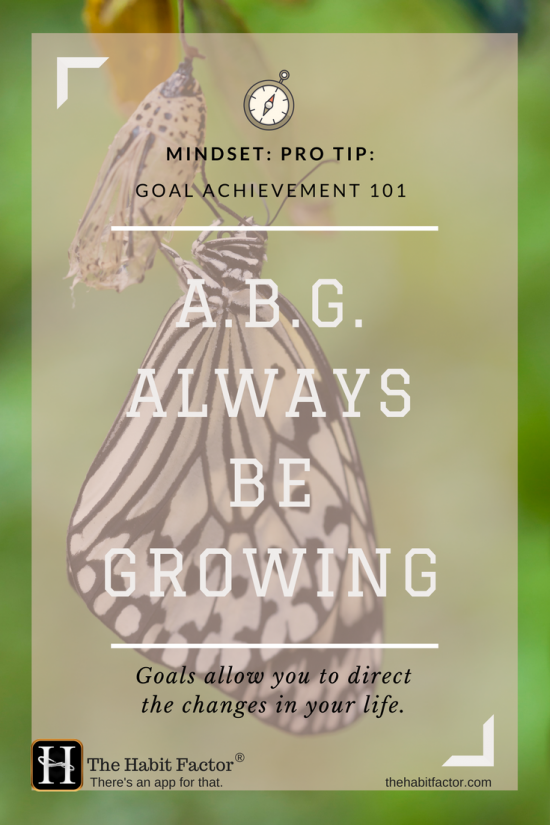
2) Set those personal goals to direct change where and when you can
3) Focus on the process, crafting supportive behaviors — habits — that will help you to achieve your goal!
https://www.sas.upenn.edu/~duckwort/images/Grit%20JPSP.pdf
https://www.psychologytoday.com/blog/wired-success/201104/why-goal-setting-doesnt-workThe Best Blog Post Ever!

Habit and Skill Development: The Four Stages of Competence
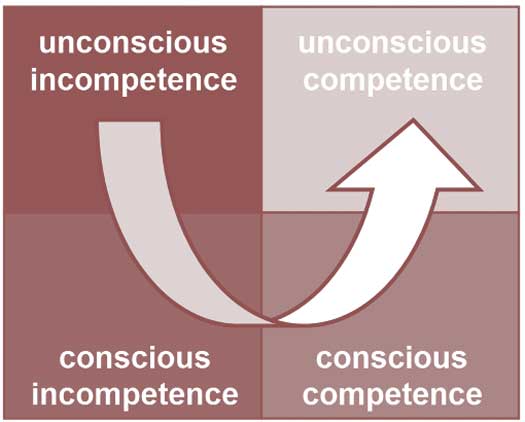
7 Habits to Help Cultivate Your Enthusiasm
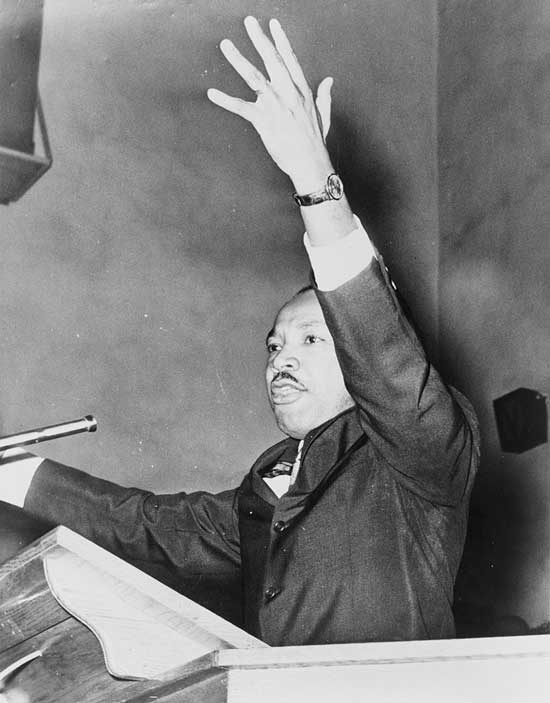
The Habit of Enthusiasm Makes the Difference


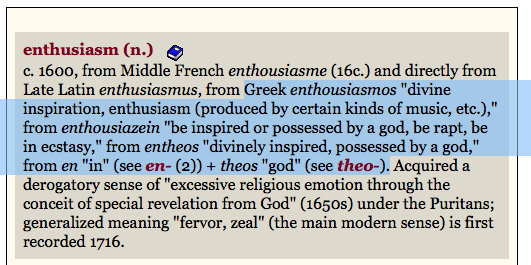
How to Get Unstuck & Breakthrough in the New Year!
6 Essential Questions to Ask Yourself at Year’s End

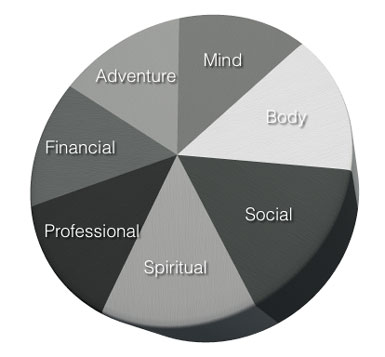

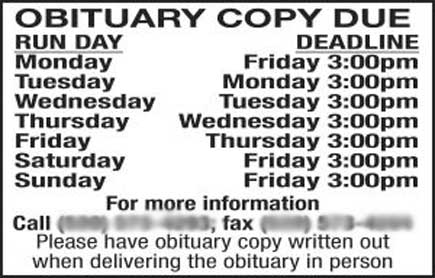
More on Gratitude: 11 Ways Gratitude is a Game-Changer
This study shows that grateful participants made better financial decisions.
There are several apps that can help with this; in this podcast interview w/ R. Michael Anderson, he shares his favorite practice and tool.Success, Happiness & the Law of Indirect Effort
